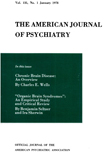Abstract
1. The methods available for genetic investigations in man are the pedigree or family history method, the contingency method of statistical prediction, and the twin study method.
2. A study of the relative effects of hereditary and environmental factors in the development and outcome of schizophrenia was undertaken by means of the "Twin Family Method." The study was organized with the cooperation of all mental hospitals under the supervision of the New York State Department of Mental Hygiene. The total number of schizophrenic twin index cases, whose cotwins were available for examination at the age of fifteen years, was 794.
3. In addition to 1,382 twins, the 691 twin index families used for statistical analysis include 2,741 full siblings, 134 half-siblings, 74 step-siblings, 1,191 parents, and 254 marriage partners of twin patients. The random sampling of these twin index pairs is indicated by the distribution of 174 monozygotic and 517 dizygotic pairs, yielding a ratio of about 1 : 3.
4. The morbidity rates obtained with the "Abridged Weinberg Method" are in line with the genetic theory of schizophrenia. They amount to 1.8 percent for the stepsiblings; 2.1 percent for the marriage partners; 7.0 percent for the half-siblings 9.2 percent for the parents; 14.3 percent for the full-siblings; 14.7 percent for the dizygotic cotwins; and 85.8 percent for the monozygotic cotwins. This morbidity distribution indicates that the chance of developing schizophrenia in comparable environments increases in proportion to the degree of blood relationship to a schizophrenic index case.
5. The differences in morbidity among the various sibship groups of the index families cannot be explained by a simple correlation between closeness of blood relationship and increasing similarity in environment. The morbidity rates for opposite-sexed and same-sexed two-egg twin partners vary only from 10.3 to 17.6 percent, and those for non-separated and separated one-egg twin partners from 77.6 to 91.5 percent. The difference in morbidity between dizygotic and monozygotic cotwins approximates the ratio of 1 : 6. An analysis of common environmental factors before and after birth excludes the possibility of explaining this difference on non-genetic grounds.
6. The difference between dizygotic and monozygotic cotwins increases to a ratio of 1 : 55, if the similarities in the course and outcome of schizophrenia are taken as additional criteria of comparison. This finding indicates that constitutional inability to resist the progression of a schizophrenic psychosis is determined by a genetic mechanism which seems to be non-specific and multifactorial.
7. The predisposition to schizophrenia, that is, the ability to respond to certain stimuli with a schizophrenic type of reaction, depends on the presence of a specific genetic factor which is probably recessive and autosomal.
8. The genetic theory of schizophrenia does not invalidate any psychological theories of a descriptive or analytical nature. It is equally compatible with the psychiatric concept that schizophrenia can be prevented as well as cured.

